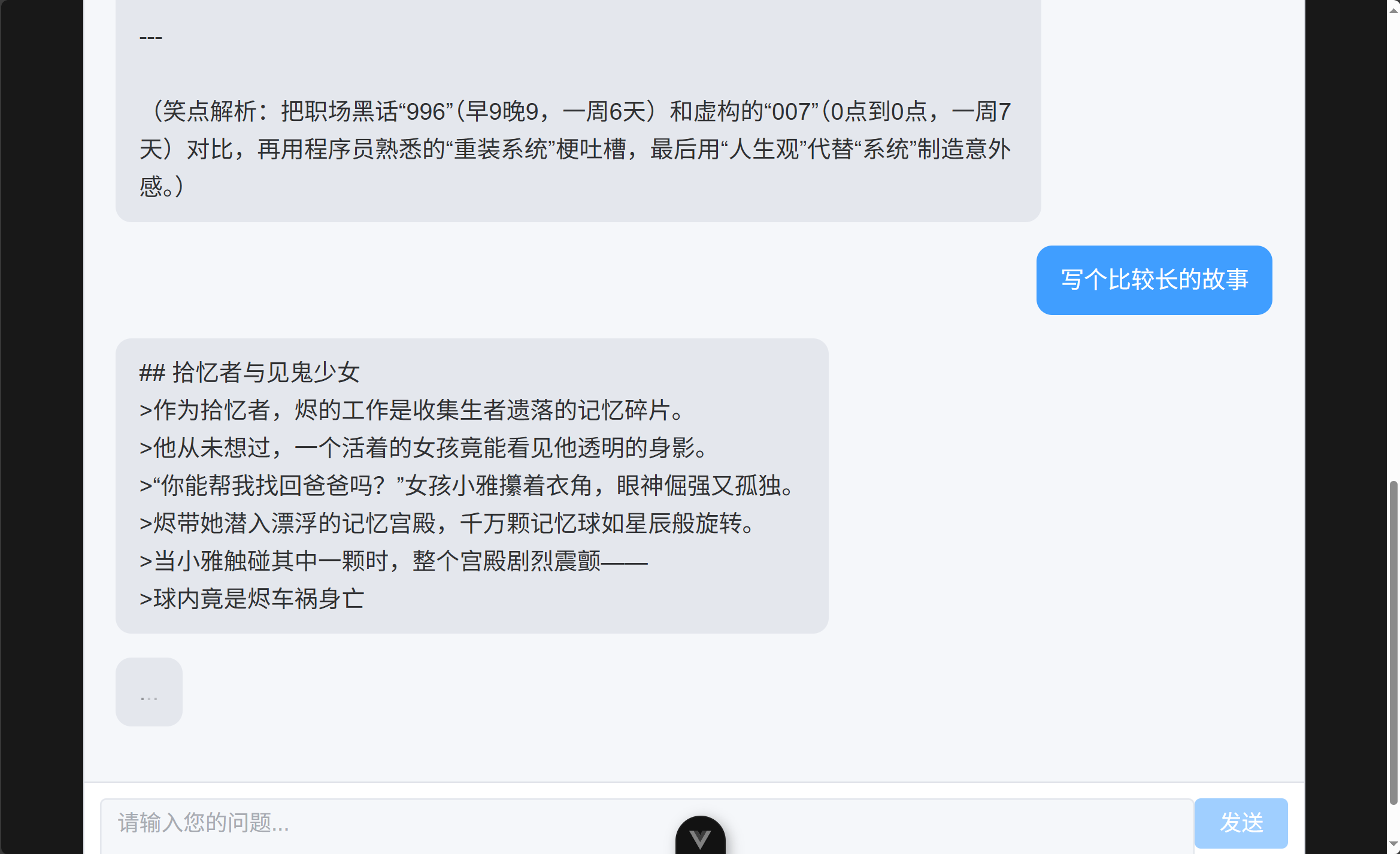手把手教你实现类ChatGPT的AI流式输出效果
作为一名技术博主,我一直关注AI领域的最新发展。今天,我将分享如何实现类似ChatGPT那样的AI流式输出效果,让你的AI应用更加生动有趣!

前言
大家好,和大家分享一个非常酷的技术实现 —— AI的流式输出。相信大家在使用ChatGPT时都被它那种一个字一个字"打出来"的效果所吸引,这种流式输出不仅提升了用户体验,还让AI回答看起来更加自然。
本文将从前后端两个方面详细讲解如何实现这一效果,并提供完整的代码示例。本教程参考了阿里云文档"阿里云ModelStudio DeepSeek API",并结合实际项目进行了优化。
什么是流式输出?
流式输出(Streaming Output)是指服务器不等待完整的响应生成完毕,而是在生成过程中逐步将数据发送给客户端的技术。这种方式有以下优点:
- 提升用户体验:用户无需等待完整响应,可以立即看到部分结果
- 降低感知延迟:即使完整响应需要较长时间,用户也能感受到系统在持续工作
- 模拟人类打字效果:让AI回答看起来更加自然,增强拟人感
技术实现
后端实现(Spring Boot + 阿里云百炼API)
在后端,我们使用Spring WebFlux结合阿里云百炼API来实现真实的AI流式响应。Spring WebFlux是Spring Framework的响应式Web框架,它基于Reactor库,支持非阻塞式的响应式编程。
以下是完整的核心代码:
package com.aso.aistreamoutput;
import com.alibaba.dashscope.aigc.generation.Generation;
import com.alibaba.dashscope.aigc.generation.GenerationParam;
import com.alibaba.dashscope.aigc.generation.GenerationResult;
import com.alibaba.dashscope.common.Message;
import com.alibaba.dashscope.common.Role;
import com.alibaba.dashscope.exception.ApiException;
import com.alibaba.dashscope.exception.InputRequiredException;
import com.alibaba.dashscope.exception.NoApiKeyException;
import io.reactivex.Flowable;
import org.springframework.web.bind.annotation.PostMapping;
import org.springframework.web.bind.annotation.RequestBody;
import org.springframework.web.bind.annotation.RequestMapping;
import org.springframework.web.bind.annotation.RestController;
import reactor.adapter.rxjava.RxJava2Adapter;
import reactor.core.publisher.Flux;
import java.util.Arrays;
@RestController
@RequestMapping("/callStream")
public class Controller {
public GenerationParam buildGenerationParam(Message userMsg) {
return GenerationParam.builder()
// 若没有配置环境变量,请用阿里云百炼API Key将下行替换为:.apiKey("sk-xxx")
.apiKey("sk-xxx")
.model("deepseek-r1")
.messages(Arrays.asList(userMsg))
// 不可以设置为"text"
.resultFormat(GenerationParam.ResultFormat.MESSAGE)
.incrementalOutput(true)
.build();
}
public Flowable<GenerationResult> streamCallWithMessage(Generation gen, Message userMsg)
throws NoApiKeyException, ApiException, InputRequiredException {
GenerationParam param = buildGenerationParam(userMsg);
Flowable<GenerationResult> result = gen.streamCall(param);
return result;
}
@PostMapping
public Flux<String> getReply(@RequestBody String prompt) throws NoApiKeyException, InputRequiredException {
Generation gen = new Generation();
Message userMsg = Message.builder().role(Role.USER.getValue()).content(prompt).build();
Flowable<GenerationResult> message = streamCallWithMessage(gen, userMsg);
// 将 RxJava Flowable 转换为 Reactor Flux
return RxJava2Adapter.flowableToFlux(message)
.map(generationResult -> {
// 提取 content 内容
return generationResult.getOutput()
.getChoices()
.get(0)
.getMessage()
.getContent();
})
.filter(content -> !content.isEmpty()); // 过滤空内容
}
}
这段代码的关键点:
- 阿里云百炼API集成:使用阿里云的百炼API(DashScope)进行AI文本生成
- 参数配置:通过
buildGenerationParam方法配置API调用参数,包括API密钥、模型选择和增量输出设置 - 流式调用:使用
streamCall方法实现流式API调用,返回RxJava的Flowable对象 - 响应式转换:将RxJava的
Flowable转换为Spring WebFlux的Flux,实现框架兼容 - 内容提取:从API响应中提取实际的文本内容
- 过滤处理:过滤掉空内容,确保前端接收到有意义的数据
这种实现方式的优势在于:
- 使用真实的AI大模型(deepseek-r1)生成高质量回复
- 通过
incrementalOutput(true)启用增量输出,实现真正的流式响应 - 结合Spring WebFlux的响应式编程模型,高效处理并发请求
配置阿里云百炼API
在使用上述代码之前,你需要进行以下准备工作:
-
获取API密钥
- 访问阿里云百炼
- 注册/登录阿里云账号
- 在控制台中创建API密钥(API Key)
- 将获得的API密钥替换代码中的
sk-xxx
-
添加Maven依赖
在pom.xml中添加以下依赖:<!-- 阿里云百炼SDK --> <dependency> <groupId>com.alibaba</groupId> <artifactId>dashscope-sdk-java</artifactId> <version>2.8.5</version> </dependency> <!-- Spring WebFlux --> <dependency> <groupId>org.springframework.boot</groupId> <artifactId>spring-boot-starter-webflux</artifactId> </dependency> <!-- RxJava2 适配器 --> <dependency> <groupId>io.projectreactor.addons</groupId> <artifactId>reactor-adapter</artifactId> </dependency>
项目源码
https://gitee.com/etilic/AiStreamOutput.git
常见问题解决
-
API密钥配置
- 推荐使用环境变量配置API密钥
- 在系统环境变量中添加
DASHSCOPE_API_KEY - 或者在代码中直接设置:
.apiKey("你的API密钥")
-
跨域问题
如果遇到跨域问题,可以添加以下配置类:@Configuration public class WebConfig implements WebMvcConfigurer { @Override public void addCorsMappings(CorsRegistry registry) { registry.addMapping("/**") .allowedOrigins("http://localhost:5173") .allowedMethods("GET", "POST", "PUT", "DELETE", "OPTIONS") .allowedHeaders("*") .allowCredentials(true); } } -
流式响应超时
如果遇到响应超时问题,可以在application.properties中配置:spring.webflux.base-path=/ spring.webflux.static-path-pattern=/** spring.webflux.timeout=30000
前端实现(Vue 3)
前端使用Vue 3和Axios来处理流式响应。以下是核心代码:
// ChatDialog.vue
<script setup>
import { ref, onMounted } from 'vue';
import axios from 'axios';
const inputMessage = ref('');
const messages = ref([]);
const loading = ref(false);
const sendMessage = async () => {
if (!inputMessage.value.trim()) return;
// 添加用户消息
const userMessage = inputMessage.value;
messages.value.push({
content: userMessage,
isUser: true
});
// 添加AI消息占位
const aiMessageIndex = messages.value.length;
messages.value.push({
content: '',
isUser: false
});
inputMessage.value = '';
loading.value = true;
try {
// 发送请求并处理流式响应
const response = await axios.post('/callStream', {
message: userMessage
}, {
responseType: 'text',
onDownloadProgress: (progressEvent) => {
// 获取已接收的数据
const responseText = progressEvent.currentTarget.response;
// 更新AI消息内容
messages.value[aiMessageIndex].content = responseText;
}
});
// 确保最终内容已更新
messages.value[aiMessageIndex].content = response.data;
} catch (error) {
console.error('Error:', error);
messages.value[aiMessageIndex].content = '抱歉,发生了错误,请稍后再试。';
} finally {
loading.value = false;
}
};
</script>
这段代码的关键点:
- 使用
ref()创建响应式变量存储消息和状态 - 发送消息时,先添加用户消息和AI消息占位
- 使用Axios发送POST请求,设置
responseType: 'text' - 关键是
onDownloadProgress回调函数,它会在接收到新数据时触发 - 在回调中更新AI消息内容,实现流式显示效果
前端模板部分
<template>
<div class="chat-container">
<div class="messages-container" ref="messagesContainer">
<div v-for="(msg, index) in messages" :key="index"
:class="['message', msg.isUser ? 'user-message' : 'ai-message']">
<div class="message-content">{{ msg.content }}</div>
</div>
</div>
<div class="input-container">
<el-input
v-model="inputMessage"
placeholder="请输入您的问题..."
:disabled="loading"
@keyup.enter="sendMessage"
/>
<el-button
type="primary"
@click="sendMessage"
:loading="loading"
>
发送
</el-button>
</div>
</div>
</template>
配置代理解决跨域问题
在前端开发中,我们通常会遇到跨域问题。使用Vite作为构建工具时,可以通过配置代理来解决:
// vite.config.js
export default defineConfig({
// ...其他配置
server: {
proxy: {
'/callStream': {
target: 'http://localhost:8080',
changeOrigin: true,
secure: false
}
}
}
})
进阶优化
- 错误处理:添加更完善的错误处理机制,包括网络错误、服务器错误等
- 打字效果:可以添加打字机效果,控制文字显示速度
- Markdown渲染:如果AI回复包含Markdown,可以使用库如
marked进行渲染 - 代码高亮:对代码块进行语法高亮处理
- 重试机制:添加请求失败后的重试逻辑
实际应用场景
这种流式输出技术适用于多种场景:
- AI聊天机器人:提供类似ChatGPT的交互体验
- 实时翻译工具:边输入边翻译
- 代码生成工具:实时生成并展示代码
- 内容创作助手:帮助用户撰写文章、邮件等
总结
通过本文的介绍,我们学习了如何使用Spring Boot和Vue 3实现AI的流式输出效果。这种技术不仅可以提升用户体验,还能让你的AI应用更加生动有趣。希望这篇教程对你有所帮助!
如果你想了解更多关于AI应用开发的内容,欢迎关注我的博客,我会持续分享更多实用技术和经验。

参考资料
如果你觉得这篇文章有帮助,别忘了点赞、收藏和关注哦!有任何问题也欢迎在评论区留言,我会及时回复。
























 1746
1746

 被折叠的 条评论
为什么被折叠?
被折叠的 条评论
为什么被折叠?








